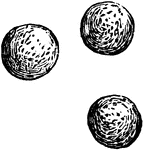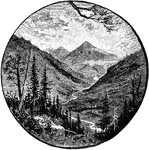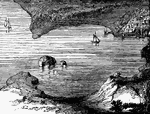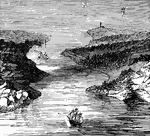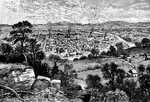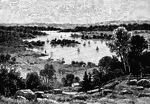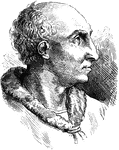
Ghiberti, Lorenzo
This is a painting of the artist, Lorenso Ghiberti. The artist who painted the image is unknown.
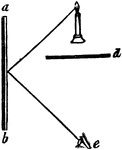
Plane Mirror
"Suppose the mirror, a b, to be placed on the side of a room, and a lamp to be set in antoher room,…
!["This will be understood [here] where the ray of light A B, proceeding from the eye, falls perpendicularly on the plane mirror B D. will be reflected back in the same line; but the ray C D coming from the feet, which falls obliquely on the mirror, will be reflected back under the same angle in the line D A; and since we see objects in the direction of the reflected rays, and the image appears at the same distance behind the mirror that is object is before it, we must continue the line A D to the feet, E, and for the same reason, the rays A B, from the eye, must be prolonged to F, as far behind the mirror as the line E extends, where the whole image will be represented." -Comstock 1850](https://etc.usf.edu/clipart/35800/35843/mirror3_35843_mth.gif)
Mirror Half the Length of the Object
"This will be understood [here] where the ray of light A B, proceeding from the eye, falls perpendicularly…

Curved Image
"If the object a be placed obliquely before the convex mirror, then the converging rays from its two…
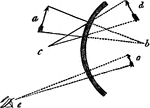
Object Diminished in Convex Mirror
"Hence the image of the object, when reflected from the convex mirror, appears smaller than the object…
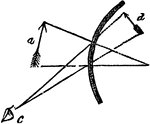
Convex Mirror
"To explain this, let us suppose that the arrow a, is diminished by reflection from the convex surface,…
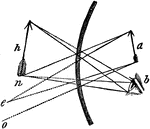
Object Within the Focus in a Concave Mirror
"...let us suppose the object a, to be placed before the mirror, and nearer to it than the principal…

Object Beyond the Focus in a Concave Mirror
"...if the object is placed more remote from the mirror than the principal focus, and between the focus…

Cornea too Convex on Eye
"If the cornea is too convex, or prominent, the image will be formed before it reaches the retina, for…

Cornea too Concave on Eye
"...and the cornea will become too flat, or not suffciently convex, to make the rays of light meet at…

Indistinct Vision
"...where we suppose that the object a, is brought within an inch or two of the eye, and that the rays…

Compound Microscope
"This consists of two convex lenses, by one of which the image is formed within the tube of the instrument,…

Solar Microscope
"This consists of two lenses, one of which is called the condesner, because it is employed to concentrate…
Refracting Telescope
"Suppose a, to be a distinct object, from which pencils of rays flow from every point toward the object…
Refracting Telescope
"Suppose the object o to be at such a distance, that the rays of light from it pass in parallel lines,…

Image by Aperature
"If light from a highly luminous body is admitted to a darkened room through a small hole in the shutter…

Regular Reflection
"Regular reflection results from the incidence of radiant energy upon a polished surface. When a beam…
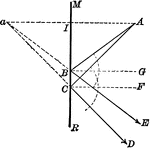
Plane Mirror
"If an object is placed before a plane mirror, a virtual image appears behind the mirror. Each point…
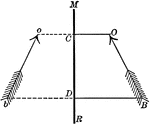
Object in Plane Mirror
"The construction for the image produced by a plane mirror depends upon the fact that the image of the…
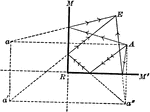
Multiple Images in a Plane Mirror
"By placing two plane mirrors facing each other, we may produce an indefinite series of images of an…

Concave Mirror with Image and Focus
"The focus of each point chose may be determined by tracing two rays from the point, and locating their…
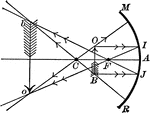
Image Beyond the Curvature of a Concave Mirror
"When the object is at a distance from the mirror somewhat greater than the center of curvature, as…

Spherical Aberration of a Concave Mirror
"The spherical aberration of a concave mirror is the deviation of some of the reflected light from the…

Convex Mirror Reproducing an Image of an Arrow
"Rays from an object showing the reproduction of an image in a convex mirror." -Avery 1895

Object Refracted through Biconvex Lens
"Showing how an object is refracted through a biconvex lens." -Avery 1895

Refraction of Complimentary Colors
"The prism will deflect the red and orange, and form a reddish colored image at n. The violet, indigo,…

Eye Focusing on Object
"Showing how the image of an object which is seen is formed on the retina of the eye." —Croft 1917

Inverted Image
"Slit A is a very small opening. The light coming from the soldier on the right shines through the slit…

Reflection by Convex Mirrors
"Parallel rays strike the convex mirror, reflect, and diverge as if they had originated from a virtual…
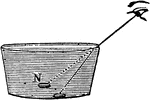
Refraction as seen by the Human Eye
"If the coin were to be observed in an empty pan and then watched as the pan was filled with water,…
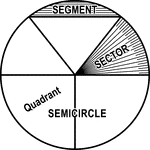
Circle with Segment, Semicircle, Sector, Quadrant, and Central Angle
Illustrations of a circle with segment, semicircle, sector, quadrant, and central angles drawn.
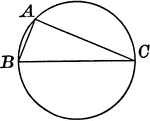
Circle With Inscribed Right Angle in Semicircle
Illustration of a circle with a right angle inscribed in a semicircle.
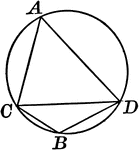
Circle With Inscribed Angle Greater Than Semicircle
Illustration of a circle with an angle inscribed in a segment greater than a semicircle, an acute angle.
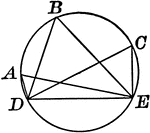
Circle With Inscribed Angle Less Than Semicircle
Illustration of a circle with an angle inscribed in a segment less than a semicircle, an obtuse angle.

Right Triangle Inscribed in Semicircle Shows Mean Proportional
Right triangle inscribed in semicircle. Illustration shows that the perpendicular from any point in…
